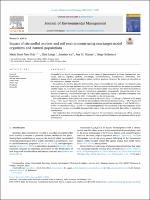Por favor, use este identificador para citar o enlazar este ítem:
https://repositorio.usj.es/handle/123456789/1058
| Título : | Impact of citronellol on river and soil environments using non-target model organisms and natural populations |
| Autor: | Pino Otín, Rosa


Langa Morales, Elisa 
Val, Jonatan 


Mainar, Ana M. 


Ballestero Fernández, Diego |
| Palabras clave : | Ecotoxicology; Soil and water bacteria; Eisenia fetida; Allium cepa; Periphyton; Citronellol |
| Fecha de publicación: | 26-feb-2021 |
| Editorial : | Elsevier |
| Citación : | María Rosa Pino-Otín, Elisa Langa, Jonatan Val, Ana M. Mainar, Diego Ballestero, Impact of citronellol on river and soil environments using non-target model organisms and natural opulations, Journal of Environmental Management, Volume 287, 2021, 112303, ISSN 0301-4797, https://doi.org/10.1016/j.jenvman.2021.112303. |
| Resumen : | Citronellol is an acyclic monoterpenoid with a wide range of pharmacological activities (antibacterial, antifungal, anti-lice, repellent, lipolytic, anti-allergic, anti-inflammatory, antispasmodic, antidiabetic, anticholesterol, among other) and potential to replace synthetic products. However, the impact of citronellol on the environment remains unknown. We analysed, for the first time, the environmental impact of citronellol on river and soil environments using non-target model organisms and natural populations. The acute toxicity of citronellol on the aquatic invertebrate Daphnia magna, the plant Allium cepa L and the earthworm Eisenia fetida was quantified. The effect of citronellol in a river ecosystem was analysed using river periphyton communities taxonomically characterised and a river microbial community characterised through 16 S rRNA gene sequencing. Finally, a microbial community from natural soil was used to monitor the effect of citronellol on the soil ecosystem. The results showed that E. fetida was most sensitive to citronellol (LC50 = 12.34 mg/L), followed by D. magna (LC50 = 14.11 mg/L). Citronellol affected the photosynthesis of the fluvial periphyton (LC50 = 94.10 mg/L) and was phytotoxic for A. cepa. Furthermore, citronellol modified the growth and metabolism of both fluvial (LC50 = 0.19% v/v) and edaphic (LC50 = 5.07% v/v) bacterial populations. The metabolism of the microorganisms in the soil and water exposed to citronellol decreased with respect to the control, especially their ability to metabolise carbohydrates. Our results show that citronellol has a negative impact on the environment. Although acute effects cannot be expected, it is necessary to quantify the environmental levels as well as the long-term and persistent effects of this monoterpene. |
| URI : | https://repositorio.usj.es/handle/123456789/1058 |
| ISSN : | 0301-4797 |
| Aparece en las colecciones: | Artículos de revistas |
Ficheros en este ítem:
| Fichero | Descripción | Tamaño | Formato | |
|---|---|---|---|---|
| Impact of citronellol on river and soil environments using non-target model.pdf | 7,5 MB | Adobe PDF |  Visualizar/Abrir |
Este ítem está sujeto a una licencia Creative Commons Licencia Creative Commons

